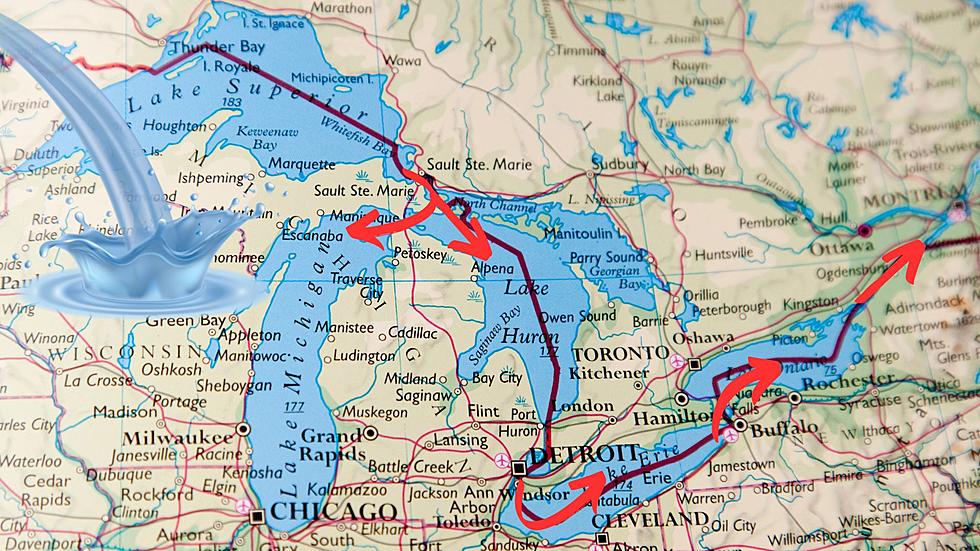
How Long Would It Take For Water to Flow Through All Five Great Lakes?
The Great Lakes are named that for a reason... THEY'RE HUGE! And they hold a LOT of water - 21 percent of the world's surface freshwater to be precise.
So, with that much water involved,it begs the question... how long would it take for ALL of the water to flow into, and out of the Great Lakes and be completely replaced?

Each of the lakes are connected through a series of canals, locks, and rivers. Water from Lake Superior flows down into Lakes Huron, Michigan, Erie, and Ontario, before finally emptying into the St. Lawrence River that flows into the Gulf of St. Lawrence, and into the Atlantic Ocean.
For one droplet of water to make that journey from Lake Superior to the Gulf of St. Lawrence could take years, or even potentially centuries!
Lake Superior - 191 Years
More than 200 rivers flow into Lake Superior. Originally, it got its water source from melting glaciers, which also cut its unique shape into the land. But now, it relies on winter melting and river inflow. That seems to be plenty, though, as it maintains a volume of 2,900 cubic miles of water, and is the western Hemisphere's largest freshwater lake. Alone, it holds 10% of the world's surface fresh water.
Because of its depth and size, water in Lake Superior, on average, takes about 191 years to be completely replaced.
Lake Huron - 22 Years
By surface area, Lake Huron is the second-biggest lake in the Great Lakes but only holds about 850 cubic miles of water - a staunch step down from Lake Superior. But it serves as the central point for water distribution across the Great Lakes Region. In fact, it feeds into TWO of the other Great Lakes and is the only lake to share the same surface level as another Great Lake - Lake Michigan - which is shares the five-mile-wide Straits of Mackinac with.
Due to its position below Lake Superior, and because it actually feeds into TWO other Great Lakes, water in Lake Huron, on average, only takes about 22 years to be completely replaced.
Lake Michigan - 99 Years
Aside from a few major rivers, the only main inlet of water for Lake Michigan comes from Lake Huron. It's the only Great Lake where the inlet, and outlet in the Great Lakes water system is the same spot - the Straits of Mackinac.
Lake Michigan is the second-largest of the lakes by volume, at 1,180 cubic miles of water, and third-largest by surface area.
But its unique setup of only one major inlet/outlet for water makes it more difficult for water to flow directionally through the lake. As a result, it can take, on average, about 99 years for all of the water in Lake Michigan to be completely replaced.
Lake Erie - 3 Years
We're now through the three largest lakes in the system, and Lake Erie is where we really pick up some speed. By volume, Erie is the smallest Great Lake at only 116 cubic miles of water. Its main inlet is from the Detroit River, which flows down from Lake Huron, and from Lake St. Clair. It does have some other inlets from other rivers, but in terms of "Great Lakes" water alone, it's one of the fastest.
Due to its shallow nature, and how water flows through it, Lake Erie has the shortest time for water retention. On average, Lake Erie can replace all of its water in just 3 years.
Lake Ontario - 6 Years
Now, we come to the end of the road in the Great Lakes System. Water has now flowed downstream through the four other lakes. But its shortest, and maybe most turbulent ride comes as it tumbles into the Niagara River, and over Niagara Falls. Lake Ontario is the fourth largest in volume at 393 cubic feet, but the smallest in surface area. It's also the only lake that has SOME man-made control over the lake's levels with the Long Sault Control Dam, downstream on the Saint Lawrence River - the Lake's main outlet.
As such, with it being the end of the line, and with the dam partway down the river, the lake actually holds onto its water a little longer than Lake Erie. Lake Ontario can replace all of its water in about 6 years.
The Full Journey - 321 Years
So, if you're a water droplet, fresh into Lake Superior, it could take up to 321 years for you to completely make your journey through the entire Great Lakes system, and into the St. Lawrence River, eventually emptying into the Gulf of St. Lawrence.
For reference, The United States of America is only 247 years old. So, theoretically, there's water still in Lake Michigan, and downstream in the smaller Lakes that have been there since BEFORE we were a country.
Pretty wild stuff!
The Five Forgotten Great Lakes
